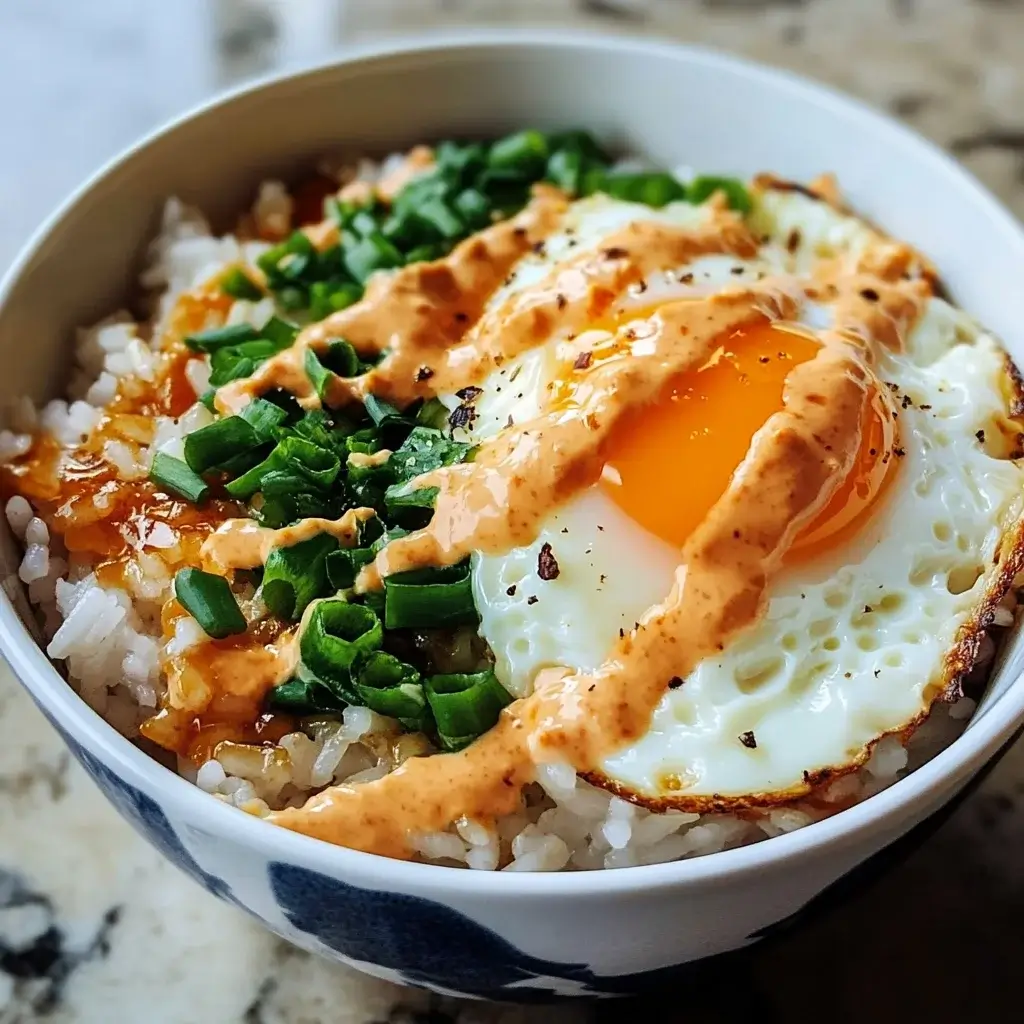There are some days when cooking feels like a chore, and others when you crave something comforting, quick, and undeniably delicious. The Hearty Egg & Rice Bowl has become a staple in our home for exactly those moments. It’s the kind of meal that comes together in minutes, using ingredients you likely already have on hand, and yet it delivers a satisfying and flavorful experience every single time. My kids, who can be notoriously picky eaters, gobble this down without a fuss, and my husband and I appreciate its versatility – perfect for a speedy weeknight dinner, a lazy weekend brunch, or even a nutritious lunch. Honestly, it’s become our go-to “I don’t know what to make” meal, and it never disappoints. The beauty of this recipe lies in its simplicity and adaptability; you can customize it to your taste and mood with endless variations. Let me share with you how to make this family-favorite Hearty Egg & Rice Bowl – it’s about to become a regular in your rotation too!
Ingredients
This recipe is incredibly flexible, so feel free to adjust quantities based on your preferences and the number of servings you desire. This list is for approximately 2 servings as a main meal.
- For the Base:
- 1 cup cooked rice (white rice, brown rice, jasmine rice, basmati rice, or even leftover rice – all work wonderfully)
- 1 tablespoon sesame oil (adds a nutty and aromatic flavor, can substitute with olive oil or avocado oil if preferred)
- 1 clove garlic, minced (freshly minced garlic is best for flavor, but ½ teaspoon of garlic powder can be used in a pinch)
- ½ cup chopped vegetables (options include spinach, kale, mushrooms, bell peppers, zucchini, carrots, or any combination you enjoy. Frozen vegetables, thawed and drained, also work well)
- ¼ cup vegetable broth or water (helps to steam the vegetables and create a bit of moisture)
- 1 tablespoon soy sauce (regular or low-sodium, tamari for gluten-free option, coconut aminos for soy-free and slightly sweeter option)
- ½ teaspoon rice vinegar (adds a touch of tanginess, apple cider vinegar or lemon juice can be substituted)
- Pinch of red pepper flakes (optional, for a touch of heat)
- Salt and black pepper to taste
- For the Eggs:
- 2-4 large eggs (depending on if you want 1 or 2 eggs per serving, adjust accordingly)
- 1 teaspoon cooking oil (vegetable oil, canola oil, or olive oil are good choices for frying eggs)
- For Toppings (Optional but Highly Recommended):
- 2 tablespoons chopped scallions (green onions, adds freshness and mild onion flavor)
- 1 tablespoon sesame seeds (toasted sesame seeds provide a wonderful nutty crunch and aroma)
- Sriracha or chili garlic sauce (for extra spice lovers)
- Furikake seasoning (Japanese seasoning blend, adds umami and texture)
- Nori seaweed strips, crumbled (adds a salty, savory, and slightly briny flavor)
- Avocado slices (for creaminess and healthy fats)
- Kimchi (for a fermented and spicy kick)
- Pickled ginger (for a tangy and refreshing palate cleanser)
- Microgreens or sprouts (for added nutrients and visual appeal)
Instructions
This Hearty Egg & Rice Bowl comes together in just a few simple steps. Follow these instructions for a delicious and satisfying meal in minutes.
- Prepare Your Vegetables (If Using Fresh): If you are using fresh vegetables like bell peppers, zucchini, or carrots, wash and chop them into bite-sized pieces. Leafy greens like spinach or kale can be roughly chopped. If using frozen vegetables, ensure they are thawed and drained to remove excess water. This step ensures even cooking and prevents your bowl from becoming watery.
- Sauté Garlic and Vegetables: Heat the sesame oil in a skillet or wok over medium heat. Add the minced garlic and sauté for about 30 seconds until fragrant, being careful not to burn it. Burnt garlic can become bitter. Add your chosen chopped vegetables to the skillet. Sauté for 3-5 minutes, or until the vegetables are slightly tender-crisp, depending on your preference. If you like softer vegetables, cook them a bit longer.
- Steam Vegetables and Add Flavor: Pour in the vegetable broth or water to the skillet. Cover the skillet and let the vegetables steam for another 2-3 minutes, or until they reach your desired tenderness. Steaming helps to cook the vegetables through and retain their moisture. Remove the lid and add soy sauce, rice vinegar, and red pepper flakes (if using). Stir well to combine all the flavors and ensure the vegetables are evenly coated. Taste and adjust seasoning with salt and pepper as needed. Remember that soy sauce is already salty, so add salt cautiously.
- Cook Your Eggs: While the vegetables are steaming, prepare your eggs. You can cook eggs in various ways for this bowl, but pan-fried eggs are a classic and quick option. Heat cooking oil in a separate non-stick skillet over medium heat. Once the oil is hot, gently crack the eggs into the skillet. Cook to your desired doneness. For runny yolks (sunny-side up or over-easy), cook for 2-3 minutes. For firmer yolks (over-medium or over-hard), cook for 4-5 minutes, flipping halfway through for over-easy, over-medium, or over-hard. Season the eggs with a pinch of salt and pepper while they are cooking. Alternatively, you can poach or soft-boil your eggs for a different texture and flavor profile. Poached eggs offer a delicate and silky texture, while soft-boiled eggs provide a creamy yolk.
- Assemble Your Hearty Egg & Rice Bowl: Divide the cooked rice between two bowls. Spoon the sautéed vegetables over the rice. Carefully place one or two cooked eggs on top of the vegetables in each bowl. This is where the magic happens as the warm egg yolk will gently coat the rice and vegetables, creating a luscious sauce.
- Add Toppings and Serve Immediately: Garnish generously with your chosen toppings. Sprinkle with chopped scallions and sesame seeds. If you like it spicy, drizzle with sriracha or chili garlic sauce. Add furikake, nori, avocado, kimchi, pickled ginger, or microgreens as desired. Serve immediately and enjoy your delicious and nutritious Hearty Egg & Rice Bowl! The warmth of the rice and vegetables combined with the perfectly cooked egg and flavorful toppings creates a symphony of textures and tastes.
Nutrition Facts (Approximate, per serving)
- Serving Size: 1 bowl (approximately half of the recipe)
- Calories: 450-550 kcal (This is an estimate and can vary depending on the type of rice, vegetables, oil, and toppings used. Using brown rice and lean vegetables will lower the calorie count, while adding avocado or richer toppings will increase it.)
Note: These are approximate values and can vary. For a more accurate nutritional breakdown, use a nutrition calculator app and input the specific ingredients and quantities you use. This recipe is a good source of protein, healthy fats, and carbohydrates, making it a balanced and satisfying meal. It can be further enhanced by adding a wider variety of vegetables to increase vitamin and mineral content.
Preparation Time
- Prep Time: 10 minutes (Chopping vegetables, mincing garlic, gathering ingredients)
- Cook Time: 15 minutes (Sautéing vegetables, steaming, cooking eggs)
- Total Time: 25 minutes
This recipe is perfect for busy weeknights or anytime you need a quick and wholesome meal. The prep time is minimal, and the cooking process is fast and efficient. You can further reduce the preparation time by using pre-cooked rice and pre-chopped vegetables, making it an even faster meal option.
How to Serve Your Hearty Egg & Rice Bowl
This versatile dish can be served in numerous ways, making it adaptable to different occasions and preferences.
- As a Quick Breakfast: Start your day with a protein-packed and energizing bowl. It’s a much healthier and more satisfying alternative to sugary cereals or pastries. The combination of rice, eggs, and vegetables provides sustained energy to fuel your morning.
- For a Speedy Lunch: Perfect for a work-from-home lunch or a quick midday meal. It’s easy to prepare and can be enjoyed hot or at room temperature. You can even pack the rice and vegetable mixture separately and cook the egg fresh at lunchtime if possible.
- As a Light yet Filling Dinner: Ideal for weeknights when you want a delicious and nutritious dinner without spending hours in the kitchen. It’s satisfying without being overly heavy, making it a great option for a balanced evening meal.
- Customize with Different Toppings: Set up a topping bar and let everyone customize their own bowl. This is a fun way to cater to individual tastes and preferences, especially if you have picky eaters. Offer a variety of toppings like different sauces, seeds, vegetables, and proteins.
- Pair with Side Dishes (Optional): While the bowl is satisfying on its own, you can enhance your meal with simple side dishes. Consider:
- Miso Soup: A light and savory soup that complements the flavors of the rice bowl.
- Seaweed Salad: Adds a refreshing and briny element.
- Kimchi or Pickled Radishes: Provides a spicy and tangy contrast.
- Steamed Edamame: A healthy and protein-rich side.
- Simple Green Salad: For added freshness and fiber.
Additional Tips for the Best Hearty Egg & Rice Bowl
Here are five helpful tips to elevate your Hearty Egg & Rice Bowl experience and make it even more delicious and convenient.
- Use Leftover Rice for Speed and Convenience: This recipe is a fantastic way to use up leftover cooked rice. Using pre-cooked rice significantly reduces the cooking time, making it a truly quick meal. Store leftover rice properly in the refrigerator and ensure it is heated thoroughly when reheating.
- Experiment with Different Egg Cooking Methods: Don’t limit yourself to just fried eggs! Try poached, soft-boiled, or even scrambled eggs for different textures and flavor profiles. Poached eggs offer a silky and delicate texture, while soft-boiled eggs have a creamy yolk. Scrambled eggs can be a great option if you prefer a more integrated egg texture throughout the bowl.
- Get Creative with Vegetables and Protein: Feel free to swap out or add different vegetables based on what you have on hand or what’s in season. Broccoli florets, snap peas, corn kernels, or even roasted sweet potatoes would be delicious additions. For extra protein, consider adding cooked chicken, tofu, shrimp, or edamame to the bowl. This makes the recipe even more substantial and customizable to your dietary needs.
- Make it Ahead for Meal Prep: You can prepare the rice and vegetable mixture ahead of time and store it in the refrigerator for up to 3 days. When ready to eat, simply reheat the mixture and cook the eggs fresh. This makes meal prepping for lunches or quick dinners a breeze. Store the cooked eggs separately if making ahead, and gently reheat them or cook fresh eggs for the best texture.
- Don’t Skimp on Toppings!: Toppings are what truly elevate this simple bowl to a flavorful and exciting meal. Experiment with a variety of toppings to find your favorite combinations. Fresh herbs, crunchy seeds, spicy sauces, creamy avocado – they all add layers of flavor and texture that make each bite interesting and delicious. Consider keeping a variety of toppings on hand to easily customize your bowls throughout the week.
FAQ Section: Your Questions Answered
Here are some frequently asked questions about making the Hearty Egg & Rice Bowl, to help you troubleshoot and customize this recipe to your liking.
Q1: Can I make this recipe vegetarian or vegan?
A: Yes, absolutely! This recipe is easily adaptable for vegetarians. To make it vegan, simply omit the egg and ensure your vegetable broth and soy sauce are vegan-friendly (most soy sauces are, but always check). For a vegan protein boost, consider adding pan-fried or baked tofu, tempeh, or edamame to the bowl. Nutritional yeast can also be sprinkled on top for a cheesy, umami flavor often associated with eggs.
Q2: What type of rice works best for this bowl?
A: The beauty of this recipe is that any type of cooked rice works well! White rice, brown rice, jasmine rice, basmati rice, or even leftover sushi rice are all great options. Brown rice will provide more fiber and a slightly nuttier flavor, while jasmine rice will be fragrant and fluffy. Choose your favorite or whatever you have on hand. For a quicker cooking option, consider using instant rice.
Q3: Can I add meat to this recipe?
A: Yes, definitely! Adding cooked meat can make this bowl even more substantial and protein-rich. Shredded cooked chicken, ground turkey or beef, thinly sliced steak, or even leftover roasted pork would be delicious additions. You can sauté the meat with the vegetables or add it in at the end to warm through. Consider marinating the meat beforehand for extra flavor.
Q4: How can I make this recipe spicier?
A: There are several ways to increase the spice level of this bowl. You can add more red pepper flakes to the vegetable mixture. Drizzle sriracha, chili garlic sauce, gochujang (Korean chili paste), or your favorite hot sauce over the finished bowl. You can also incorporate spicy ingredients like chopped jalapeños or a dash of cayenne pepper into the vegetable sauté. Start with a small amount of spice and add more to taste to reach your desired heat level.
Q5: Can I store leftovers of this Hearty Egg & Rice Bowl?
A: It’s best to consume the Hearty Egg & Rice Bowl fresh for the best texture, especially the egg. However, you can store the cooked rice and vegetable mixture in an airtight container in the refrigerator for up to 3 days. Reheat the mixture thoroughly before serving. It’s recommended to cook the eggs fresh when you are ready to eat to ensure the yolks are perfectly cooked and not rubbery from reheating. If you must store cooked eggs, they are best consumed within 1-2 days and may have a slightly altered texture upon reheating.
Print
Hearty Egg & Rice Bowl
Ingredients
This recipe is incredibly flexible, so feel free to adjust quantities based on your preferences and the number of servings you desire. This list is for approximately 2 servings as a main meal.
- For the Base:
- 1 cup cooked rice (white rice, brown rice, jasmine rice, basmati rice, or even leftover rice – all work wonderfully)
- 1 tablespoon sesame oil (adds a nutty and aromatic flavor, can substitute with olive oil or avocado oil if preferred)
- 1 clove garlic, minced (freshly minced garlic is best for flavor, but ½ teaspoon of garlic powder can be used in a pinch)
- ½ cup chopped vegetables (options include spinach, kale, mushrooms, bell peppers, zucchini, carrots, or any combination you enjoy. Frozen vegetables, thawed and drained, also work well)
- ¼ cup vegetable broth or water (helps to steam the vegetables and create a bit of moisture)
- 1 tablespoon soy sauce (regular or low-sodium, tamari for gluten-free option, coconut aminos for soy-free and slightly sweeter option)
- ½ teaspoon rice vinegar (adds a touch of tanginess, apple cider vinegar or lemon juice can be substituted)
- Pinch of red pepper flakes (optional, for a touch of heat)
- Salt and black pepper to taste
- For the Eggs:
- 2–4 large eggs (depending on if you want 1 or 2 eggs per serving, adjust accordingly)
- 1 teaspoon cooking oil (vegetable oil, canola oil, or olive oil are good choices for frying eggs)
- For Toppings (Optional but Highly Recommended):
- 2 tablespoons chopped scallions (green onions, adds freshness and mild onion flavor)
- 1 tablespoon sesame seeds (toasted sesame seeds provide a wonderful nutty crunch and aroma)
- Sriracha or chili garlic sauce (for extra spice lovers)
- Furikake seasoning (Japanese seasoning blend, adds umami and texture)
- Nori seaweed strips, crumbled (adds a salty, savory, and slightly briny flavor)
- Avocado slices (for creaminess and healthy fats)
- Kimchi (for a fermented and spicy kick)
- Pickled ginger (for a tangy and refreshing palate cleanser)
- Microgreens or sprouts (for added nutrients and visual appeal)
Instructions
This Hearty Egg & Rice Bowl comes together in just a few simple steps. Follow these instructions for a delicious and satisfying meal in minutes.
- Prepare Your Vegetables (If Using Fresh): If you are using fresh vegetables like bell peppers, zucchini, or carrots, wash and chop them into bite-sized pieces. Leafy greens like spinach or kale can be roughly chopped. If using frozen vegetables, ensure they are thawed and drained to remove excess water. This step ensures even cooking and prevents your bowl from becoming watery.
- Sauté Garlic and Vegetables: Heat the sesame oil in a skillet or wok over medium heat. Add the minced garlic and sauté for about 30 seconds until fragrant, being careful not to burn it. Burnt garlic can become bitter. Add your chosen chopped vegetables to the skillet. Sauté for 3-5 minutes, or until the vegetables are slightly tender-crisp, depending on your preference. If you like softer vegetables, cook them a bit longer.
- Steam Vegetables and Add Flavor: Pour in the vegetable broth or water to the skillet. Cover the skillet and let the vegetables steam for another 2-3 minutes, or until they reach your desired tenderness. Steaming helps to cook the vegetables through and retain their moisture. Remove the lid and add soy sauce, rice vinegar, and red pepper flakes (if using). Stir well to combine all the flavors and ensure the vegetables are evenly coated. Taste and adjust seasoning with salt and pepper as needed. Remember that soy sauce is already salty, so add salt cautiously.
- Cook Your Eggs: While the vegetables are steaming, prepare your eggs. You can cook eggs in various ways for this bowl, but pan-fried eggs are a classic and quick option. Heat cooking oil in a separate non-stick skillet over medium heat. Once the oil is hot, gently crack the eggs into the skillet. Cook to your desired doneness. For runny yolks (sunny-side up or over-easy), cook for 2-3 minutes. For firmer yolks (over-medium or over-hard), cook for 4-5 minutes, flipping halfway through for over-easy, over-medium, or over-hard. Season the eggs with a pinch of salt and pepper while they are cooking. Alternatively, you can poach or soft-boil your eggs for a different texture and flavor profile. Poached eggs offer a delicate and silky texture, while soft-boiled eggs provide a creamy yolk.
- Assemble Your Hearty Egg & Rice Bowl: Divide the cooked rice between two bowls. Spoon the sautéed vegetables over the rice. Carefully place one or two cooked eggs on top of the vegetables in each bowl. This is where the magic happens as the warm egg yolk will gently coat the rice and vegetables, creating a luscious sauce.
- Add Toppings and Serve Immediately: Garnish generously with your chosen toppings. Sprinkle with chopped scallions and sesame seeds. If you like it spicy, drizzle with sriracha or chili garlic sauce. Add furikake, nori, avocado, kimchi, pickled ginger, or microgreens as desired. Serve immediately and enjoy your delicious and nutritious Hearty Egg & Rice Bowl! The warmth of the rice and vegetables combined with the perfectly cooked egg and flavorful toppings creates a symphony of textures and tastes.
Nutrition
- Serving Size: one normal portion
- Calories: 550






